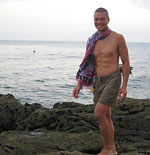|
|
 |

 March 18-19, 2006 Saturday
March 18-19, 2006 Saturday
La Luz Beach Resort
It's almost exactly to the day last year when I tagged along the UP Skin Diving class to La Luz Resort in Laiya, Batangas. Thanks to fellow UP Skin Divers member, Louie Mencias, who still conducts the class, I'm able to tag along again. Likewise, it was great hanging out with his dynamic assistants - Kaloy and David, who at one time, I did yoga with.
Progress
The area of Laiya has considerably grown since then...more resorts have sprung up and it's harder to make a weekend booking. Additionally, prices aren't cheap anymore. It seems that the Matabungkay and Nasugbu crowd have discovered the place and checking it out. However, there are still locals who would be happy to rent out their cottage for much cheaper than the established resorts.
Hands-On Management
Management seems to have a good grasp on things - the reef is cordoned off to keep the small boats from dropping anchor and ruining the corals. They're also seeding the area with giant clams. Owner, Rommel Marasigan, is very hands-on with operations and it shows. The resort has considerably grown from its rag-tag beginnings to what it is now.
Corals
Along the Laiya coast, La Luz boasts of having a monopoly on the coral reef - it's right in front of the resort. Other resorts would ply their customers by boat to La Luz for some skin diving fun. The corals have a monochromatic grayish green hue - nothing of the loud reds and blues I used to see in Puerto Gallera back in the day. I was told that it's an effect of crown-of-thorns infestation (which has since been stopped) and some dynamite fishing from the old days. This seems to be a recurring theme with coral reefs nowadays. La Luz is definitely not alone with this dilemma. It's fortunate that management is well aware of this and undertaking appropriate measures to ensure the corals are protected.
Marine Life
What the reef lacks in color, it makes up with its vibrant marine life. There are 3 resident sea turtles who are docile and allow people to get near. Fishes are friendlier too. I came upon a school of huge parrot fish feeding off the corals. I got close without spooking them. They seem to know that anything within the cordoned area is friendly. Other dive highlights include seeing moray eels, large sea cucumbers and very colorful shell-less sea slugs.
Ending Thoughts
There's an unmistakable zen to diving. It's perhaps the closest thing to being in another world - the inhabitants, the colors, the flight sensation, the creeping low temperature, etc. It's wild.
Given the neglect and abuse we have given our reefs, we are close to losing all that. Case in point: I've had a little chat with a young skin diver who couldn't believe my description of the loud and vivid colors I used to see back in the day. She thought the picture-perfect coral reef posters (screaming blues, loud greens and vicious reds) were Photoshop-tweaked! She added that she has been to several reefs and only sees the same subdued colors at best. Worse, the entire reef is a massive graveyard giving only hints of its once vibrant seascape. Given the trend, I'm afraid of what's left for the next generation.
It's pleasing to know though that some resort owners factor-in the preservation of the ecology into their bottom line. It's not rocket science. A vibrant coral reef can only be good business along the lines of tourism revenues. I also give credit to the grassroots environmentalists (like Louie, David and Kaloy) who take on the thankless task of reaching out to resort owners and fishing locals to impart their knowledge and skill set to preserve the reefs in particular, and the environment as a whole. These are small beginnings that ripple out and hopefully influence a few more.
--- TheLoneRider

»» next story: Bike Harabas sa Baras 2006
»» next Skin Diving story: Vistamar Beach Resort - a Last Hurrah
»» back to Skin Diving
»» back to Homepage
|
 |
 |
 |
 March 18-19, 2006 Saturday
March 18-19, 2006 Saturday








 Outdoor Adventure Tours
Outdoor Adventure Tours
 SandCastles Palawan Beach Resort
SandCastles Palawan Beach Resort



